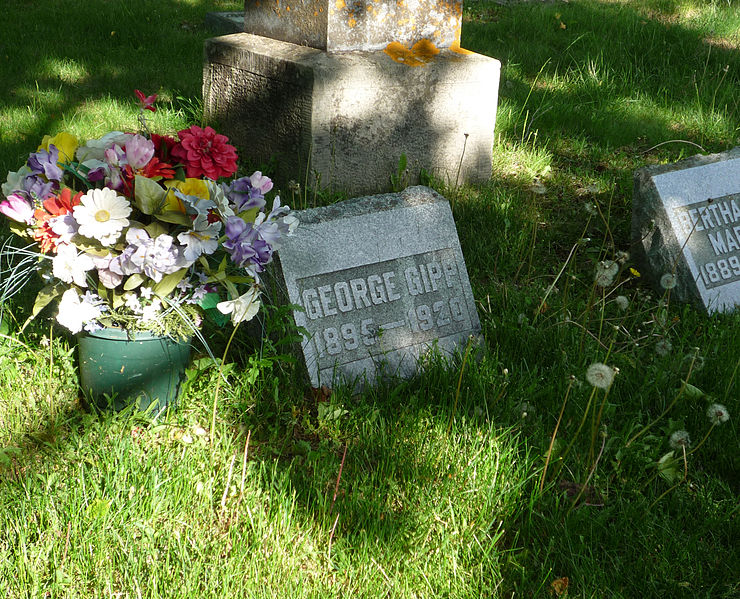
Born in Laurium, Michigan, on the Keweenaw Peninsula, George Gipp entered Notre Dame intending to play baseball for the Fighting Irish, but was recruited by Knute Rockne for the football team, despite having no experience in organized football. During his Notre Dame career, Gipp led the Irish in rushing and passing each of his last three seasons (1918, 1919 and 1920). His career mark of 2,341 rushing yards lasted more than 50 years until Jerome Heavens broke it in 1978.[2] Gipp also threw for 1,789 yards. He scored 21 career touchdowns, averaged 38 yards a punt, and gathered five interceptions as well as 14 yards per punt return and 22 yards per kick return in four seasons of play for the Fighting Irish. Gipp is still Notre Dame’s all-time leader in average yards per rush for a season (8.1), career average yards per play of total offense (9.37), and career average yards per game of total offense (128.4).
Gipp died December 14, 1920, two weeks after being elected Notre Dame’s first All-American by Walter Camp and second consensus All-American overall. A frequently told but probably apocryphal story of Gipp’s death begins when he returned to Notre Dame’s campus after curfew from a night out. Unable to gain entrance to his residence, Gipp went to the rear door of Washington Hall, the campus’ theatre building. He was a steward for the building and knew the rear door was often unlocked. He usually spent such nights in the hall. On that night, however, the door was locked, and Gipp was forced to sleep outside. By the morning, he had contracted pneumonia and eventually died from a related infection.
It is more likely that Gipp contracted strep throat and pneumonia while giving punting lessons after his final game, November 20 against Northwestern University. Since antibiotics were not available in the 1920s, treatment options for such infections were limited and they could be fatal even to young, healthy individuals.
It was on his hospital bed that he is purported to have delivered the famous,”win just one for the Gipper” line. He apparently said this line to Knute Rockne, the football coach of Notre Dame. The full quotation from which the line is derived is:
“I’ve got to go, Rock. It’s all right. I’m not afraid. Some time, Rock, when the team is up against it, when things are wrong and the breaks are beating the boys, ask them to go in there with all they’ve got and win just one for the Gipper. I don’t know where I’ll be then, Rock. But I’ll know about it, and I’ll be happy.”
Rockne used the story of Gipp, along with this deathbed line that he attributed to Gipp, to rally his team to a 12-6 underdog victory over the undefeated Army team of 1928 with Jack Chevigny making the famous, “that’s one for the Gipper” tying touchdown at Yankee Stadium. Chevigny was later killed in action in World War II at Iwo Jima.
The phrase “Win one for the Gipper” was later used as a political slogan by Ronald Reagan, who in 1940 portrayed Gipp in Knute Rockne, All American and was often referred to as “The Gipper”. His most famous use of the phrase was at the 1988 Republican National Convention when he told Vice President George H. W. Bush, “George, go out there and win one for the Gipper.” The term was also used by President George W. Bush at the 2004 Republican Convention when he honored the recently deceased President Reagan by stating, “this time we can truly win one for the Gipper.”
Gipp’s hometown, Laurium, built a memorial in his honor; he is buried in nearby Lake View Cemetery in Calumet, Michigan
Sources :
Historical Society of Michigan.
George Gipp biography from Laurium, Michigan website.